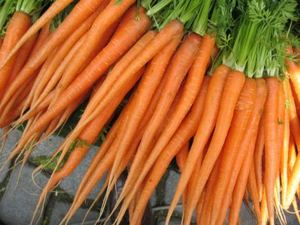You might think that growing root vegetables like carrots in containers is hard, if not impossible. However, it has become the only way I will grow potatoes or carrots. One large round container can yield between thirty and forty carrots per harvest; depending on weather, variety, and how many you plant. My favorite advantage is that there are no more critters getting to my carrots before I do, unless you count my children. What’s more, now I can easily have two or more crops to harvest in a season and the harvesting is incredibly simple.
Any container shape will work; the only concern in choosing a container is making sure the container is deep enough. Be sure to read the specific information for the variety, or varieties, that you decide to grow. Some require significantly more or less depth than others. You can use traditional pots of any shape, or use re-purposed containers. If you are re-purposing a container, be sure that there is adequate drainage. Drilling a few holes in the bottom of the container should be enough to take care of this. In fact, this year I am growing some carrots in a Omaha Steak cooler that I am re-purposing just for carrots.
I recommend choosing containers at least a foot square, but bigger is better simply for being able to grow even more vegetables. For best results, I suggest filling the container with peat and soil intended for container gardening or growing vegetables. Carrots do best in soil with high potassium content, since potassium encourages root growth. Be cautious about the nitrogen levels in your soil though, since nitrogen promotes the growth of the greens, which is not the goal in growing carrots. All of these things can be purchased in any home and garden center.
An organic fertilizer can be used, as well as organic and all natural pest control methods if they become necessary. However, the pest control should not become necessary unless there are severe conditions or infestations in your area. The only problem you might run into with carrots, is one that is common with root vegetables. Make certain that the roots, the vegetable, stay under the soil. If the actual carrot is exposed to sunlight for extended periods it will turn green and bitter. So make sure that the roots stay completely covered with soil.
1. Make sure that the chosen container has adequate drainage. If it does not, simply drill some holes in the bottom and you are all set.
2. Place the container in a location that receives the amount of sunlight best for the variety of carrot you are growing. Most carrots do best in full sun, but double-check the seed package for the variety you are growing before deciding on a location. It is best to place the container before filling, because a large container will become heavy after it is full of soil.
3. Fill the container with potting soil. You can also use additives like peat moss and compost to provide the most beneficial growing conditions for your vegetables.
4. Gently sprinkle the carrot seeds onto the soil. Lightly tamp down the seeds so that they are covered with a light layer of soil. You can plant as early as two or three weeks before the last expected frost, and keep growing rotating crops through the late fall.
5. Water gently, and keep the soil moist, and maintain it that way through harvest time. Carrots actually grow sweeter if the soil they are in stays moist, but this does not mean saturated. Do not keep the soil soaked, or you could end up with rot and soggy seeds rather than sweet tasty carrots.
6. Germination usually takes around ten days, so take some time and do your other gardening while nature works its magic. If you are too eager to wait that long, you can speed things up a little by soaking the carrot seeds for a few hours before planting.
7. As the seedlings grow they might become intertwined at the top since they are growing so close together. The best way to manage your seedlings is to thin the seedlings before this can happen. You can trim off the seedlings you are willing to part with using a pair of scissors or by pulling them gently from the soil. Be careful not to disturb the surrounding plants. For most carrots, it is best to leave three to four inches between carrots, but again it is best to double-check the recommended growth space on your seed packets because this does very by variety.
8. As the carrots grow, remember to keep the soil moist. Weeds and pests should not be an issue since the carrots are container bound, by keeping an eye out for any problems, no matter how unlikely, will ensure a good crop of carrots. You can add organic fertilizers or compost tea as the carrots grow, but you do not have to. I often just water and add some peat and additional soil, partly to add nutrients and partly to be sure the orange portion of the carrots stay completely covered with soil.
9. Harvest the carrots when they are bright orange, unless you are growing a variety shaded differently from the average carrot. It is best to keep those seed packets around through harvest, since they really do have all the information you need to make sure that the specific variety you are growing does the best that it can.
10. You can reuse the container and soil around five harvest before it will need to be replaced. So at this point feel free to add any soil amendments you want and plant another batch of carrot seeds, repeat, and enjoy the healthy harvest. Depending on where you live, you might be able to keep growing carrots year round, particularly if your container is in a sun-room or well-lit porch.
A major benefit for container gardening for a family is that it is easy to let the kids take part, or even take responsibility for a single container or type of vegetable. The reason this is easier to do with container gardening, is because you will not have to worry about them trampling the plants you are trying to grow, or nurturing the weeds you want to remove. With this kind of versatility and teamwork taking root; your garden, patio, or sun room can look any way you want it to while still proving your entire family with delicious, nutritious, home-grown produce.
Other benefits to growing carrots in containers is the control you have as a gardener of the soil quality, lack of weeding issues, and a variety of options for apprentice of your garden and landscape. The only downside to planting anything in a container, is that you need to pay much more attention to watering, since the soil dries out much faster in any container than a traditional garden.




